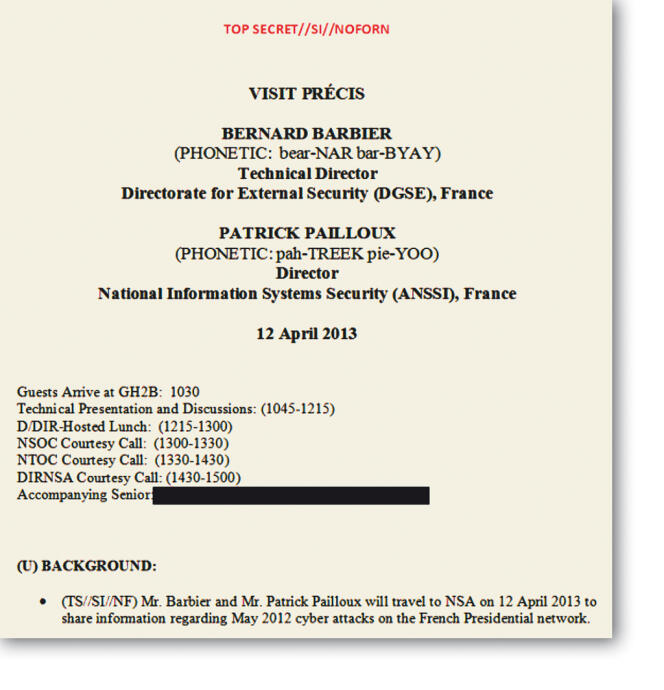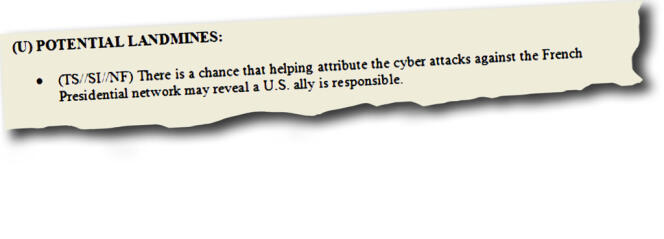This article was originally published on October 25, 2013.
The creation within ten years by the United States of an unprecedented electronic espionage system all over the world has generated tensions with countries nevertheless considered to be historical allies, such as France. The examination by Le Monde of unpublished documents from the NSA (National Security Agency) - the agency in charge of digital and other communications, shows the tensions and distrust between Paris and Washington.
Read also the French version: How Paris suspected the NSA of hacking the Elysée
One of these is a four-page internal NSA memo, revealed by Edward Snowden, the agency's ex-consultant, and marked 'top secret', the highest degree of confidentiality. It was sent to the administration of the NSA by the French service in charge of external relations and sets out the main lines of the visit, on 12 April 2013, of two top French officials. The object of the visit: the IT attack in May 2012, targeting the presidency of the French republic. The memo stated that Bernard Barbier, technical director of the DGSE (external French secret service) and Patrick Pailloux, the director of the ANSSI (the National Agency for the security of IT systems) are coming to ask their American counterparts, whom they suspect are behind this hacking, for an explanation.

These four pages mix considerations about organization with the findings of an inquiry into the grounds of the complaints of the French. We learn that none of the services capable of carrying out this type of electronic attack within American Intelligence (NSA or CIA) or amongst the close friends of the second circle (British or Canadian) are apparently responsible for this operation hostile to the Elysee. At the close of his overview in which each word is carefully chosen the editor specifies that during the research, the NSA "intentionally did not ask either the Mossad or the ISNU (the technical administration of the Israeli services) whether they were involved" in this espionage operation against the head of the French government.
This affair began in May 2012, between the two rounds of the French Presidential elections. Nicolas Sarkozy's staff were still in the Elysée. As Le Télégramme revealed, security systems were to detect the presence of detectors enabling the capture of information from the Presidency and mechanisms for pirating the computers of the major collaborators of the Head of State. "The attack was not part of an act of sabotage which was to be made public but of the desire to be permanently installed invisibly at the center of the Presidency," explained an expert speaking about the incident.

In November 2012,L'Express published an article indicating the Americans as the people behind the attack. Tension then rose between the two capitals. In January 2012, during his brief visit to Paris, General Keith Alexander, the head of the NSA, was questioned by the DGSE and the ANSSI concerning the responsibility of his agency. The Directorate of External Relations at the NSA explained in the preparatory memo for the 12 April visit that at "no point had the DGSE or the ANSSI informed him about their intention to question General Alexander about this." To attempt, or to appear, to prove their good faith, the NSA planned to send two analysts from the NTOC (the NSA's crisis center) in March to assist the French in finding the attacker. On the eve of their departure, France cancelled their visit and hardened their tone demanding that MM. Barbier and Pailloux be given a hearing at the NSA on 12 April 2013. The internal NSA document notes that at no point did the French transmit the elements at their disposal concerning the possible responsibility of the Americans. "Doubtless because the French want to see how the NSA responds when they present their findings," states the memo as a hypothesis.
It is in the chapter headed "potential traps" and "other information" in the document that we read the details of the NSA research into this affair. The author of the memo delivers to his superiors the state of the agency's knowledge to deal with the accusations. Thus we read that the TAO service (Tailored access operation) which manages and carries out the NSA's cyber attacks throughout the world confirmed that the attack did not concern any of its operations. The document specifies that "TAO had asked most of the NSA's closest partners in the second circle (CIA, GCHQ [the British secret services] and the CSEC [the Canadian services] were the main suspects) whether they were involved; all denied involvement". The first circle includes the sixteen American intelligence agencies, the second adds the United Kingdom, Canada, Australia and New Zealand and the third includes countries like France and Germany.

To supplement the information for the heads of the NSA, the memo takes the trouble to add that the Mossad and its technical department, the ISNU, also capable of carrying out this type of attack had,"intentionally" not been questioned about this affair. To justify this reserve, the author suggested, laconically "France is not an approved target for joint discussion by Israel and the United States". The NSA does not say that the Mossad carried out the attack but nevertheless, seems to consider it necessary to mention the existence of a reasonable doubt as regards the Jewish state.
The close relation between Washington and Tel-Aviv in the field of intelligence does not rule out a degree of mistrust. In a document dated 2008, published by the Guardian, a top official at the NSA refers to the aggressiveness of the Israeli intelligence service concerning the United States. "France is not the only country to target the Department of Defense using electronic espionage, Israel also does this. On one hand, the Israelis are excellent partners in terms of sharing information but on the other, they target us to find out our positions on the Middle East (...) It is the third most aggressive intelligence service in the world against the United States".

As far as relations between the French and Israeli secret services are concerned, they are close and regular on the Middle East, in particular recently on Syria. But confidence is sometimes undermined by the fairly intense activity of the Israeli intelligence services on French soil. The Arab and African world transits through France and according to a member of the French counter-espionage (DCRI) department, they have even complained to the Mossad after having observed that the Mossad had used a hotel in Paris as one of the bases of the operation which led to the assassination, in January 2010, in Dubai, of one the military heads of the Palestinian Islamist movement, the Hamas.
Questioned by Le Monde about the elements contained in the NSA memo, the Israeli Prime Minister's office stated that "Israel is a country which is a friend, ally and partner of France and does not carry out any hostile activity which could pose a threat to its security". The DGSE and the ANSSI were also contacted and refused to comment, while at the same time they did not deny the 12 April visit to the NSA. The national co-coordinator for intelligence at the Elysee, Alain Sabulon, did not wish to answer our questions. The American authorities noted that the activities of the intelligence service "were carried out according to law".